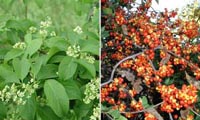Resource Library
Plant of the Week: Bittersweet
The University of Arkansas System Division of Agriculture does not promote, support or recommend plants featured in "Plant of the Week." Please consult your local Extension office for plants suitable for your region.
Plant of the Week
Bittersweet
Latin: Celastrus scandens

Sunlight is critical for plant growth, and not surprisingly, plants have devised all manner of strategies to attain this all-important resource.
Getting bigger is an often-used approach, but other plants pursue a more insidious approach - they became vines. The American bittersweet, Celastrus scandens, is one of our native vines that makes its presence known this time of year.
Bittersweet is a fast growing deciduous vine with simple, alternate, oval leaves that grow to about 2 inches long. The vines climb by twining around other plants, sometimes girdling, but not killing the plant that supports them. It’s not a high climber, seldom seen more than 15 feet off of the ground. Plants usually form thickets, spreading laterally by orange root suckers.
The small, not especially showy, sweetly fragrant, greenish-white, four-petaled flowers of bittersweet appear in late May in terminal panicles. Plants are dioecious with fruit produced only on female plants.
Bittersweet belongs to the Celastraceae family and is a close relative of euonymus. It ranges from eastern Canada, throughout most of the eastern states to as far west as New Mexico. Smith shows it growing only in the Ozarks region of Arkansas.
The main season of interest for American bittersweet is fall when the fruit burst
open revealing bright orange-red, pea sized, three-segmented balls backed with a leathery,
three parted
creamy backing. The gaudy, easily dried branches make them suitable for use in flower
arrangements and the color scheme is even seasonally appropriate.
Some references list this species as potentially poisonous, but the evidence is scant. The berries, although not at all pulpy, have a slightly sweet taste and leave behind an astringent aftertaste. Birds relish them, but they don’t do much for me.
Bittersweet is the kind of native plant that has some wonderful ornamental characteristics and some truly frightening traits. If yours is a wild garden or you have a farmette with lots of room, it would be easy to find an out –of-the-way corner where it could be planted.
But in smaller gardens, it needs to be planted carefully so it doesn’t take over. Were I to grow it, I would plant it in a sunny position in some kind of large buried container - say a 15-gallon nursery pot with drainage holes in the bottom. This would keep its rambling roots in check and allow the top to produce a good display.
If you’re to have fruit, both a male and female plant is needed. They could be planted together in the same hole.
Another strategy for using it would be to train bittersweet to a chain-link fence that has lawn area on both sides. Mowing would prevent it from spreading, except down the length of the fence. As with any willfully vigorous vine, limits should be established and the plant cut back severely each spring whenever it reaches the pre-established limits of spread.
Even though it produces a copious crop of fruit, it’s usually found in well defined thickets, indicating to me that its main means of spread is by the underground suckers, not seeds.
By: Gerald Klingaman, retired
Extension Horticulturist - Ornamentals
Extension News - December 2, 2005
The University of Arkansas System Division of Agriculture does not maintain lists of retail outlets where these plants can be purchased. Please check your local nursery or other retail outlets to ask about the availability of these plants for your growing area.